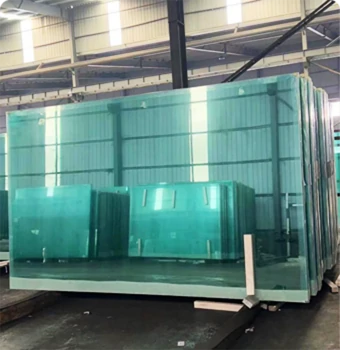Understanding Float and Flat Glass A Comprehensive Overview
Float and flat glass are integral components of modern architecture, construction, and design. These materials have revolutionized the way we perceive and utilize glass in various applications, from windows and facades to decorative elements. This article aims to explore the intricacies of float and flat glass, how they are produced, their characteristics, applications, and the benefits they offer.
The Production Process
The term float glass refers to a specific manufacturing process that was developed in the 1950s by Sir Alastair Pilkington. The float glass process involves melting raw materials like silica sand, soda ash, and limestone at high temperatures. Once the mixture is melted, it is poured onto a bed of molten tin. The glass floats on top of the tin, creating a smooth, flat surface as it cools. This process ensures that the glass is uniform in thickness and free from imperfections.
In contrast, flat glass encompasses a broader category of glass products that are flat in shape. While float glass is one type of flat glass, other varieties include tempered glass, laminated glass, and insulated glass. These different types of flat glass are produced using various methods to meet specific requirements and performance standards.
Characteristics of Float and Flat Glass
Float glass is known for its clarity, uniformity, and smooth surface. It typically comes in various thicknesses ranging from 2mm to 19mm, making it suitable for a wide range of applications. One of the standout features of float glass is its excellent optical properties, which make it ideal for use in windows and display cases.
Flat glass, as a broader category, possesses unique characteristics depending on its type. For instance, tempered glass is treated with heat or chemicals to increase its strength, making it suitable for high-stress applications. Laminated glass consists of two or more layers of glass with an interlayer, providing enhanced safety and sound insulation. Insulated glass incorporates multiple layers with a sealed air space, offering improved energy efficiency.
Applications
float flat glass
The applications of float and flat glass are diverse and multifaceted. Float glass is predominantly utilized in the construction industry for windows, doors, and facades. It not only enhances the aesthetic appeal of buildings but also allows natural light to permeate indoor spaces, creating a welcoming environment.
Laminated glass is often used in car windshields and skylights, where safety and sound control are paramount. Its ability to hold together when shattered makes it an ideal choice for applications that prioritize safety. In architectural designs, flat glass is increasingly being used for glass facades, allowing for seamless integration of indoor and outdoor spaces.
Tempered glass finds its place in shower doors, glass railings, and other areas where strength and safety are crucial. Its shatter-resistant properties enhance safety by reducing the risk of large shards resulting from breakage.
Benefits of Float and Flat Glass
The benefits of both float and flat glass are significant. From an aesthetic viewpoint, glass provides a clean, modern look that enhances the overall design of a building or space. The transparency of glass allows for natural light to fill interiors, reducing the need for artificial lighting and contributing to energy savings.
Additionally, advancements in glass technology have led to the development of energy-efficient options, such as low-emissivity (Low-E) glass. This type of glass reflects heat while allowing natural light to pass through, making it an excellent choice for environmentally conscious designs.
Moreover, the use of float and flat glass supports sustainable practices in construction. Its durability and low maintenance requirements contribute to longer lifespans, while its recyclability presents an eco-friendly option at the end of its service life.
Conclusion
In conclusion, float and flat glass represent significant advancements in the glass industry, offering unparalleled versatility, safety, and aesthetic value. With various types catering to diverse needs, these materials have become essential components in modern architecture and design. Whether for residential or commercial use, the ongoing innovations in glass manufacturing and technology promise to enhance their applications further, making float and flat glass an enduring choice in the built environment. As we continue to strive for more sustainable and visually appealing designs, the role of glass will undoubtedly remain vital in shaping our architectural landscape.
 Afrikaans
Afrikaans  Albanian
Albanian  Amharic
Amharic  Arabic
Arabic  Armenian
Armenian  Azerbaijani
Azerbaijani  Basque
Basque  Belarusian
Belarusian  Bengali
Bengali  Bosnian
Bosnian  Bulgarian
Bulgarian  Catalan
Catalan  Cebuano
Cebuano  Corsican
Corsican  Croatian
Croatian  Czech
Czech  Danish
Danish  Dutch
Dutch  English
English  Esperanto
Esperanto  Estonian
Estonian  Finnish
Finnish  French
French  Frisian
Frisian  Galician
Galician  Georgian
Georgian  German
German  Greek
Greek  Gujarati
Gujarati  Haitian Creole
Haitian Creole  hausa
hausa  hawaiian
hawaiian  Hebrew
Hebrew  Hindi
Hindi  Miao
Miao  Hungarian
Hungarian  Icelandic
Icelandic  igbo
igbo  Indonesian
Indonesian  irish
irish  Italian
Italian  Japanese
Japanese  Javanese
Javanese  Kannada
Kannada  kazakh
kazakh  Khmer
Khmer  Rwandese
Rwandese  Korean
Korean  Kurdish
Kurdish  Kyrgyz
Kyrgyz  Lao
Lao  Latin
Latin  Latvian
Latvian  Lithuanian
Lithuanian  Luxembourgish
Luxembourgish  Macedonian
Macedonian  Malgashi
Malgashi  Malay
Malay  Malayalam
Malayalam  Maltese
Maltese  Maori
Maori  Marathi
Marathi  Mongolian
Mongolian  Myanmar
Myanmar  Nepali
Nepali  Norwegian
Norwegian  Norwegian
Norwegian  Occitan
Occitan  Pashto
Pashto  Persian
Persian  Polish
Polish  Portuguese
Portuguese  Punjabi
Punjabi  Romanian
Romanian  Russian
Russian  Samoan
Samoan  Scottish Gaelic
Scottish Gaelic  Serbian
Serbian  Sesotho
Sesotho  Shona
Shona  Sindhi
Sindhi  Sinhala
Sinhala  Slovak
Slovak  Slovenian
Slovenian  Somali
Somali  Spanish
Spanish  Sundanese
Sundanese  Swahili
Swahili  Swedish
Swedish  Tagalog
Tagalog  Tajik
Tajik  Tamil
Tamil  Tatar
Tatar  Telugu
Telugu  Thai
Thai  Turkish
Turkish  Turkmen
Turkmen  Ukrainian
Ukrainian  Urdu
Urdu  Uighur
Uighur  Uzbek
Uzbek  Vietnamese
Vietnamese  Welsh
Welsh  Bantu
Bantu  Yiddish
Yiddish  Yoruba
Yoruba  Zulu
Zulu 

